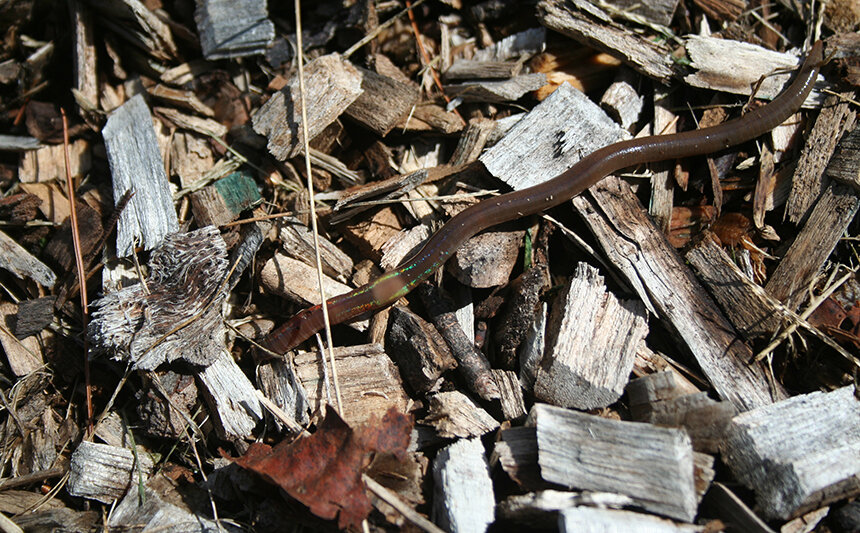By
TODD McLEISH/ecoRI News contributor

Snake
worms look similar to the region’s more common earthworms, but their behavior
easily identifies them. (Josef Gorres)
Just
hearing the name of one of Rhode Island’s newest invasive species is enough to
make local residents queasy: snake worms.
Even
though snake worms look similar to the region’s
more common earthworms and they’re not much larger, their behavior easily
identifies them. Not only do they slither through the grass like snakes, they
also jump away if you try to pick them up. In their native Korea and Japan,
they are called Asian jumping worms.
“That
jumping is how they get away from predators,” said worm expert Josef Gorres, an
associate professor of plant and soil science at the University of Vermont who
formerly taught at the University of Rhode Island. “It scares them.”
It
scares people, too.
“They can be a bit of a pest when you have a Fourth of July party and you have a new patio and they crawl around like snakes,” said Gorres, who has found the worms in his home garden in Vermont. “They make people squeamish.”
This
invader has probably been in the United States for more than 50 years. The
story told about their arrival involves a shipment of cherry trees from Japan
that was sent to Washington, D.C., and the worms were in the soil around the
tree roots.
Whether that’s true, Gorres isn’t sure, but he believes the worms have probably been in Rhode Island for a decade or more. Residents are just now beginning to notice them.
Whether that’s true, Gorres isn’t sure, but he believes the worms have probably been in Rhode Island for a decade or more. Residents are just now beginning to notice them.
A
survey of URI master gardeners conducted by Gorres in 2015 found snake worms in
Slater Park in Pawtucket and in gardens and mulch piles in Barrington,
Jamestown, North Kingstown, South Kingstown, and Richmond.
Today, the worms are common at URI’s East Farm, where master gardeners maintain several gardens and greenhouses, and they have been reported at other scattered locations around the state as well.
Today, the worms are common at URI’s East Farm, where master gardeners maintain several gardens and greenhouses, and they have been reported at other scattered locations around the state as well.
Nan
Quinlan, who coordinates the master gardeners’ vegetable demonstration garden
at East Farm in Kingston, said the worms may have arrived there in deliveries
of mulch, soil, or potted plants, or even on the tires and fenders of cars and
trucks.
“There
are so many possibilities here that I strongly hesitate to blame any one
source,” she said.
“What makes the most sense is that the Asian worms were already present in the soil at East Farm for a long time and found their way to areas like mulch piles and the compost pile we built and maintain inside the garden.”
“What makes the most sense is that the Asian worms were already present in the soil at East Farm for a long time and found their way to areas like mulch piles and the compost pile we built and maintain inside the garden.”
Quinlan’s
speculation that they may have come from deliveries of soil or potted plants
aligns with Gorres’ understanding that they are commonly transported in plant
material via the horticulture and nursery industry.
“Folks
in horticulture should worry because the worms can negatively affect their
stock of plants,” Gorres said. “The castings the worms produce are very
granular, very loose, so if anything tries to grow in the castings, the roots
will have a hard time getting a foothold. Plants need something more stable to
hold onto. It makes the plant wilt and look like they’re experiencing drought
symptoms.”
Snake
worms can be a problem in forests as well. They consume the top layer of the
soil and dead leaves — called the duff layer — where the seeds of plants
germinate.
“Once
that layer is gone, the plants don’t have a place to put their seeds where they
will survive until the following year,” Gorres said. “You end up with a forest
with fewer understory plants, and all that’s left are saplings of trees that
deer will feed on. The end result is a lack of regeneration of the forest.”
This
concern is also true of the other earthworms found in the Northeast, all of
which are non-native and could be impacting forests in a similar way. Any
native earthworms in the region were crushed by glaciers during the last ice
age. Most of the worm species found in New England today arrived following
European colonization of the area.
“We’re
now experiencing the second wave of earthworm invasions,” Gorres said. “One of
the things I’m especially worried about is that the loose castings will make
the soil highly erodible. Castings from European worms stick together. The soil
on a slope where snake worms are found might easily erode away.”
To
reduce the likelihood of the spread of snake worms, Gorres suggested that
consumers ask vendors selling plants, mulch, or soil whether the worms have
been found in their products.
“They’ll
probably say they haven’t been, but if they’re truthful they may say it’s the
new normal, which it may be,” he said.
Gorres
is studying several varieties of insect-killing fungi that may control the
worms.
David
Gregg, director of the Rhode Island Natural History Survey, cautioned that
those investigating whether they have snake worms in their gardens shouldn’t
confuse them with worm snakes, which are native to New England and may be Rhode
Island’s rarest snake. Worm snakes grow only about 10 inches long and may look
like a large scaly worm.
“Worm
snakes = good, snake worms = bad,” he wrote in an email.
Rhode
Island resident and author Todd McLeish runs a wildlife blog.